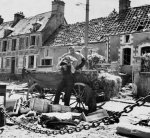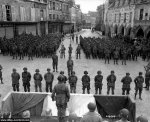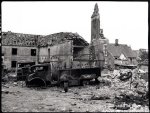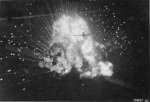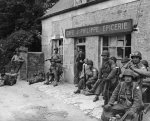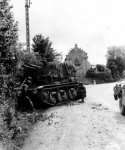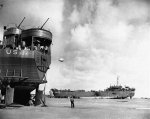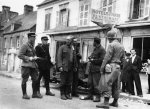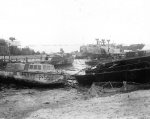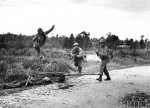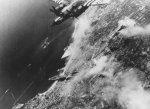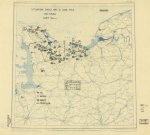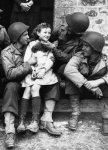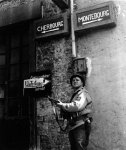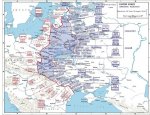June 23, 1944: The American forces of the VII Corps drive the Germans from their first line of defense in Cherbourg. Yesterday’s bombardments created lots damage and confusion in the German lines and General Collins keeps the VII Corps pushing forward, constantly attacking.
General Montgomery, who planned the Operation Epsom, lands in France and sets up his headquarters in the village of Blay, west of Bayeux. He prepares the beginning of Epsom, which should start on June 25, assuming the supply and the reinforcements of men and vehicles are not delayed. The 5th British Infantry division, which was essentially stalled by the Germans until June 18, continues to progress very slowly (capturing St. Honorina, northwest of Caen), delayed by the preparations of Epsom.
Over France, with two engines out and the fuselage on fire, Pilot Officer Andrew Mynarski, a Canadian gunner in a No. 419 Squadron Lancaster, is ordered to bale out. However, he sees that the rear gunner is trapped and tries to free him even though his own clothing and parachute are on fire. Hopelessly stuck, the rear gunner signals to Mynarski that he should save himself. The Canadian gallantly stands to attention and salutes his comrade before jumping out. He is found by the French but dies later of his terrible injuries. Amazingly, the gunner is thrown clear when the Lancaster crashed and survives, as did the other crew members who had jumped. When they return and tell their story after the war, Mynarski is posthumously awarded the Victoria Cross.
Also over France, US 8th Air Force attacks V-weapons sites with 211 bombers escorted by 161 fighters and attacks airfields and transportation lines with 196 bombers escorted by 226 fighters. US 9th Air Force attacks V-weapons sites, transportation lines, and other targets with 175 bombers and 630 fighters. RAF Bomber Command sends 412 aircraft to attack V-weapons sites and 203 aircraft to attack transportation lines - both overnight.
The German high command works hard to defend its positions in Normandy, as it believes in its revolutionary weapons such as the V-1 rockets. Many of these rockets are sent day and night - generally aimed at civilian targets in England.
On the eastern front, the Soviet attack begins. There are four front-level commands engaged in the operation, under the STAVKA direction of Marshal Zhukov (the southern wing) and Marshal Vasilevsky (the northern wing). From left to right: 1st Belorussian Front (Rokossovsky); 2nd Belorussian Front (Zakharov); 3rd Belorussian Front (Cherniakhovsky); and, 1st Baltic Front (Bagramian). The Soviet combat forces directly engaged in the offensive amount to over 1,250,000 men (in 124 divisions), over 4000 tanks and self-propelled guns, over 24,000 artillery pieces and over 6300 aircraft. Soviet objectives include tactical encirclements at Vitebsk and Bobruisk while a deep encirclement would aim for Minsk. Soviet forces are then to drive west toward the Vistula River. The target of Operation Bagration is German Army Group Center (Busch) holding a salient centered on Minsk, and including most of Belorussia. Its forces, from right to left, include: 9th Army (Jordan), 4th Army (Tippelskirch); and, 3rd Panzer Army (Reinhardt). On the right flank of the army group is the German 2nd Army (Weiss) which is not targeted by the Soviet offensive. The German defenders amount to 800,000 men in 63 divisions with about 900 tanks and assault guns, 10,000 artillery pieces and 1,300 planes. Advances of up 11 miles are recorded by Red Army troops of 2nd, 3rd Belorussian and 1st Baltic Fronts. The 1st Belorussian Front does not join in the assault during the day. Meanwhile in the far north, forces of the Soviet 7th Separate Army cross the Svir River.
In Italy, British 8th Army attacks around Chiusi and Monte San Croce. US 5th Army continues to advance slowly against German delaying positions on Route 1 and along the Orcia River. General Robert Frederick departs 1st Special Services Force to take command of 1st Airborne Task Force for invasion of southern France.
Churchill, with misgivings, gives in to pressure from the Americans and sanctions operation Anvil (the proposed US-French invasion of the south of France). Churchill calls this a “bleak and sterile exercise".
Pictured: Two French civilian refugees from the battle that raged in St. Sauveur as American troops advanced on Cherbourg on June 23, 1944, unload their cart after returning to their house (in background, with most shingles gone). 101 Airborne Division ceremony in Carentan, June 23, 1944; Canadians battle for Caen - former battalion headquarters of the Regina Rifles after it had been raked by German shell, Bretteville, June 23, 1944; P-47 Thunderbolt piloted by Capt Raymond M Walsh of the 406th Fighter Group is silhouetted against the exploding ammunition truck he just strafed, France, June 23, 1944. The image was taken by his wingman’s gun camera in the following P-47
